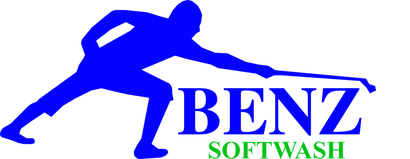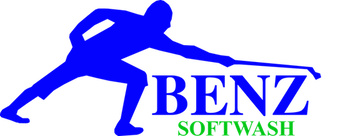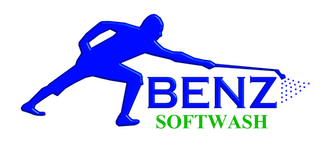- HOME
- CHEMICALS
- EQUIPMENT
- TRAINING
- SERVICES
- TRADE TIPS
- CONTACT
- Log in
-
EUR €
To use Bio Cleanze or Lightning Cleanze? – that is the question ... (video)
January 05, 2016 2 Comments

We've noticed a lot of confusion on the various forums about which softwash products to use, when to use them, and how power washing fits into the soft washing big picture. ~In this post we do our best to clarify the situation.
Watch the short video below to understand the basics
The different characteristics of our softwash biocides
Bio Cleanze is the strongest and most cost-effective quaternary ammonium ("quat") DDAC biocide in the UK and Ireland. It has a residual biocidal effect because it requires contact with organic matter to break down. Therefore some of the active ingredient is able to remain and kill spores that land on the surface in the months following treatment.
The combination of warm weather and high rainfall facillitates the rapid spread of algae. This is true especially of horizontal surfaces such as paths and drives. But on surfaces treated with Bio Cleanze we have noticed no sign of algae growth returning even after 12-24 months, which shows how powerful the residual biocidal effect is.
This affect can be seen most noticeably on surfaces that have been pre-cleaned using either Lightning Cleanze or a power washer as there is less organic matter to break down the active ingredient (DDAC).
Lightning Cleanze is a powerful formula combining a sophisticated surfactant, a pleasant scent, and high quality sodium hypochlorite. It does not have a residual biocidal effect (neither does any sodium hypochlorite based product) because the sodium hypochlorite breaks down within 30-60 minutes of application. It does not require contact with organic matter to break down, although contact speeds up that process.
Lightning Cleanze is the first treatment of choice for all surfaces that should not be power-washed – such as soft sandstone, limestone and render – which have been contaminated with heavy organic growth. Then follow up with a post-treatment of Bio Cleanze.
Treating surfaces with a softwash biocide
On vertical surfaces that do not accumulate damp, treatment with Lightning Cleanze may be sufficient for a while. Then a treatment with Bio Cleanze 12 months later, followed by ongoing bi-annual treatments with Bio Cleanze will keep most walls perpetually clean.
Quick tip: For walls in damp, shaded areas, an annual treatment with Bio Cleanze may be necessary.
Horizontal surfaces suffer from damp much more than walls, and so the potential for re-contamination is much greater. Concrete paths, patios, and drives come up well with Lightning Cleanze and benefit from an annual post-treatment with Bio Cleanze to offer permanent residual biocidal protection.
Quick tip: We recommend Bio Cleanze for tarmac as our experience is that this leaves the tarmac looking good and deals with most biological growths within 24-48 hours.
Some infestations are harder to shift than others. For example, the black lichen that can grow on concrete paths and patios can be a really tough proposition to remove. The choice of which method to use depends upon the severity of the contamination, the likelihood of re-contamination, and on whether or not you have access to a power washer.
We've used this example of treating black lichen on concrete paths and patios to illustrate the possible combinations of approach that soft washing offers:
1) Light power wash followed by Bio Cleanze (works well and provides residual biocidal effect)
2) Lightning Cleanze > Light power wash & rinse > Lightning Cleanze > Rinse (works well on severe contamination and although it has no residual biocidal effect this method reduces the materials cost)
3) Lightning Cleanze (1-2 applications) > Light power wash & rinse > Bio Cleanze (loosens up and removes severe growths prior to power washing, then offers residual biocidal protection)
4) Lightning Cleanze (1-3 applications) > Bio Cleanze (when a power washer is not available)
Dilution rates: If the contamination is not too severe, and on most non-porous surfaces, Lightning Cleanze @ 10:1 may be sufficient but for severe contamination use 5:1.
Bio Cleanze can be used to great effect at 50:1 and also as strong as 20:1. Do not apply to surfaces that will be walked on by children or animals at a strength greater than 50:1 and allow the surface to dry completely before they are allowed access.
Quick tip: Two successive treatments at 50:1 can be more effective than a single treatment at 25:1 because this allows for the active ingredient to have a longer contact time with, and a deeper penetration into, the biological growth.
You'll find from experience what combination and which dilution rate works best for specific situations and surfaces. We cannot give absolute figures and recommendations because the climatic variables of temperature, wind, sunlight, rainfall, shading, and composition of the surface being treated all vary from region to region and from job to job.
The experience needed to calculate these variables makes soft washing a skilled profession, which makes it both interesting and justifies your fees.
Quick tip: Whenever you apply Bio Cleanze following Lightning Cleanze always thoroughly rinse the surface to ensure as much of the Lightning Cleanze surfactant as possible is removed. And we suggest allowing a full 60 minutes for the sodium hypochlorite in Lightning Cleanze to completely break down before treating the surface with Bio Cleanze.
Important information about softwash surfactants
There are thousands of amine surfactants and not all are biodegradable. And some will break down sodium hypochlorite even before it reaches the surface to be cleaned.
The surfactant we use in Lightning Cleanze is highly specialised, biodegradable, and was developed by our industrial chemists specifically for use in Lightning Cleanze. The use of this high quality surfactant ensures Lightning Cleanze remains stable and does not break down the sodium hypochlorite before it reaches the surface to cleaned.
Combined with the highest quality sodium hypochlorite in Lightning Cleanze (beware cheap hypo products as all hypo is not created equal – they vary in strength, purity, and conformity with REACH regulations) means this is a very high quality product. Comparing Lightning Cleanze with cheap hypo, cheap surfactant, and cheap scent is like comparing a new BMW with an old banger.
Rinsing technique following Lightning Cleanze treatment: It's important to rinse Lightning Cleanze from the surface 30-60 minutes following application. Also to rinse between treatments if the surface requires more than one application. The fastest and most effective rinsing method is to use a power washer at low pressure, using a rinsing nozzle (a hosepipe will do but is less effective).
If you don't have a machine with adjustable pressure, use a fan jet held well away from the surface to reduce the pressure on the surface (to tap water pressure) and so as not to cause damage.
When to use Bio Cleanze:
- Soft washing roofs.
- Following power washing.
- Following a treatment with Lightning Cleanze.
- Soft washing tarmac.
- Rendered walls that are stained red or green.
- Historic buildings where care of the structure is highly important.
Examples of when to use Lightning Cleanze:
- Vertical surfaces such as rendered walls, if stained black.
- Surfaces contaminated by black stains and lichen, including concrete patios, paths, and drives.
- Soft surfaces that would be damaged by power washing, such as sandstone, limestone, and render.
- Historic buildings where care of the structure is highly important.
- When your customer demands the fastest possible results.
Examples of when to use a power washer:
- Cobblelock paths and drives to clear out the weeds, followed by Bio Cleanze.
- Heavy lichen infestation in concrete paths and patios, in conjunction with Lightning Cleanze, Tornado Cleanze and Bio Cleanze.
- Rinsing both horizontal and vertical surfaces, using a rinse nozzle or fan jet (keep pressure on the surface low by turning pressure down to tap water pressure. or keeping a fan jet well away from the surface)
We hope this information is helpful and sincerely wish you great success in your soft washing business,
Ben, Leo, Fiona, Stevie & Anthony
Click here to explore the full range of Benz softwash cleaning products
2 Responses
Tim Ogburn
March 08, 2016
Hi
i have two questions please….1) When pressure washed a block drive i used to use 5 to 1 SH is blackwash ok to use at same dilution or should i be opting for 10.1
2) when using black wash on concerete paths is it ideal to hose area then apply blackwash or is it ok as the above question
Many thanks
Tim
Leave a comment
Comments will be approved before showing up. Please revisit to read our response.
Also in Benz Trade Tips

How to remove rust stains from render
April 12, 2024
Rust stains on renders caused by flue pipes, satellite dishes, mild steel fixings, overflow pipes, etc, can be easily removed.
Click the link on this page to find out how ...

Understanding the legalities of softwash product approvals
April 05, 2024 2 Comments
In today's world of "false facts" how can you know which softwash products are legal to use and which are not?
Click the link on this page to find out ...

Spring Newsletter 2024
March 29, 2024
Welcome to our Spring quarter newsletter 2024. We catch up about all our softwashing news and discuss issues happening in the trade this season.
Click the link to read more.
About this Benz website
It's a free resource for people wanting to learn about the soft washing industry, to expand an existing business, or build a new business.
Soft washing reduces, or even eliminates, the need to use high-pressure washing.
Instead, once the build up of algae, lichen, fungus and mould – the root causes of properties looking "dirty" – has been treated, the natural "self-cleansing" of sun, rain and wind removes the surface residue through time.
By educating the cleaning trade and public about soft washing we are helping develop an industry that offers sustainable treatments to clean and maintain exterior hard surfaces.
More information
- Search this Site
- Render Cleaning How-to Manual
- Professional Softwash Training
- Customer Testimonials
- Terms of Service
- Refund policy
Support
FREE PRICING GUIDE
Subscribe to our free trade tips blog to download your "Professional Soft Wash Contractors Pricing Guide".
The free guide shows you – step by step – how to easily, quickly, and accurately create softwash business quotes.
This saves you time, is a highly professional approach, and increases your chances of winning new contracts.
© 2024 Benz Softwash Ltd.



Leo
March 17, 2016
Hi Tim
1) If you have pressure washed a drive and it is clean, then we recommed post-treating with Biocidal Wash at 40:1 (winter) and 50:1 (summer) to provide residual biocide protection. There is nothing to be gained by treating an already clean surface with Blackwash or any other SH product.
2) Hosing down paths and patios is a good idea if there is a lot of mud and organic growth. It’s a simple form of pre-cleaning that will allow the chemical to work more effectively. Brush away all puddles and ideally allow the surface to dry as much as possible before treating with Blackwash so the surface water does not further dilute the chemical.
But if the paths are clean then you can apply Blackwash to a dry surface, usually at 5:1.
I hope this helps.
Wishing you soft washing success!
Leo